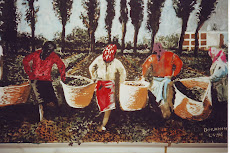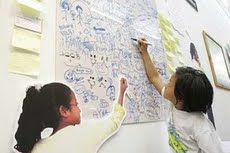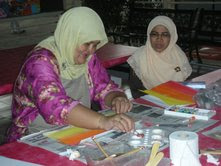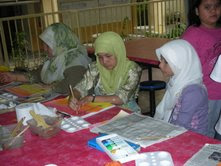MAZLINA MOHD NOOR:
Embracing matters of art
2010/04/18
By Mazlina Mohd Noor( mazlinanoor@nst.com.my)
MY first brush with fear occurred in 1987. Like the other little boys and girls in my class, I had to digest all my Year One lessons in a building facing a Chinese cemetery.
We often stared at the tombstones from our classroom window. Sometimes, we even tried to count the number of plots only to lose track through the sound of our own quickening heartbeats.
I had classes in the afternoon, so dad would usually pick me up by 6.15pm, latest. But on one particularly cloudy day, that didn't happen.
Dusk was approaching and my dad's trusty old Civic was nowhere to be seen. Buses and cars zoomed by, leaving only a few kids behind, including me, standing miserably at the porch. There were staff members scattered about, but when you're 7, hungry and in close proximity with the undead, you don't see what you should be seeing any longer.
I felt horrible. My initial feeling was that something terrible had happened to my parents. By 7pm, I had properly lost the will to live. I sobbed uncontrollably while trying hard not to look north. The sky turned yellow and I knew that once darkness took over, evil spirits would come out and grab me.
Suddenly, a familiar sight screeched to a sudden halt. Grinning from ear to ear, mum and dad swiftly packed me into the back seat of our car, completely unaware of how paranoia had almost paralysed their last born. Waving a rabbit-shaped pencil box as a token of apology, Mum rattled on about how they got delayed in traffic. But it was too late. My 7-year-old nerves had been shot to ribbons and I remember not wanting to ever feel that way again.
Yet as life would have it, fear would continue to plague my existence. It would accompany me throughout that ridiculous journey of achieving the idea of perfection that was mostly in my head. This persisted until I came across a painting which affected my perception. It was the inventive work of the eminent Spanish Catalan artist, Salvador Dali.
The Anthropomorphic Cabinet depicts a man burying his head into one of the many drawers attached to him, searching for an explanation of what is happening within.
Shadows of people lurk in the distant, and although the man seems to reach out as if telling them to stop and wait for him, he is still more interested in peering into his chest of drawers.
Dali had cleverly used bizarre imagery to illustrate the secret compartments within human beings and how they spend too much time smelling the odours that emanate from each.
Too often, I have done the exact mistake of focusing on my own inner fears and flaws. I used to draw comparisons with my peers, wondering if I was as smart or as competitive and as talented as them. I feared the unlikely and everything that was beyond my control. I blamed myself for what I thought I lacked, yet never fully addressing it. I was far too intent on being crippled by negativity.
Being self-absorbed in the most excessive manner only promotes a weaker mind and a dangerous sort of self-indulgence. When humans tend to overestimate or underestimate their own value, reality takes a dimmer view.
Dali, in his painting, had dissected this through a looking glass with a language of innocence that floats between genius and madness.
He showed me that being exposed to your deepest fear gives less power to the fear itself. I am no longer so wary of my limitations or take too much pride in my accomplishments, as if the state of my person solely depended on them.
To be too afraid, or conscious, of anything and everything certainly diverts you from what truly matters: the enjoyment of life and appreciating your loved ones.
The way art feeds minds and heals hearts never ceases to amaze me. Absorbing a painting, with its stiff, passionate dignity and moral demands can smash open a person's blocked-off sorrows.
The incredible works of Dali, who had dabbled in almost every artistic medium imaginable, from furniture to sculpture, greatly fascinate me.
He defied all conventions and charged forward with a spirit unmatched by others. The way he painted his dreams and moods in a precise illusionistic fashion produces thunderous revelations about social character.
Dali's brand of surrealism destroys only what it considers to be shackles limiting our vision, and the ideals which it expounds are nothing short of an eye-opener.
Through art, I discovered a new kind of adrenaline rush not found in pure arithmetic or fast cars. I realised that real education lies in the simplest form of aesthetics. It holds the power to change the way one views the world.
The Anthropomorphic Cabinet has reinforced my belief in the importance of being kind to myself and being brave.
As Ernest Hemingway said: "There is nothing noble in being superior to your fellow man. True nobility lies in being superior to your former self."
Sunday, April 18, 2010
Subscribe to:
Post Comments (Atom)
































.jpg)




No comments:
Post a Comment